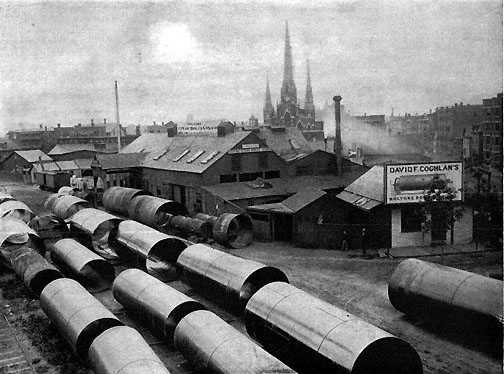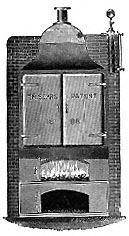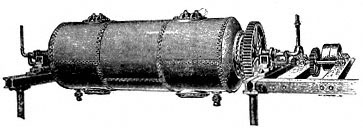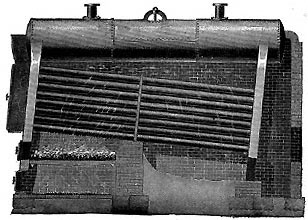The Holyoke Steam Boiler and Iron Works

The Holyoke Steam Boiler and Iron Works
|
To describe Holyoke from an industrial point of view, without treating of the great boiler works under the present management of T.H. Sears, as well as under the one who largely made them what they are — the late David F. Coghlan — would be almost unpardonable.

Front of the Sears Return
Water Tube Boiler.
|
The engraving which is shown at the head of this page is a representation of a picture familiar to every Holyoke mechanic and most business men, and here has been built up a business that is known in nearly every state of the Union, while even the "Paper City," with its great water power, has been forced to make frequent drafts upon these works for boiler aid to supplement the work of that sometimes capricious servant, water, and the great mill corporation interest of the city has been the mainstay of the Coghlan works generally, because its output included such mill necessities as tanks, penstocks, standpipes, smoke flues, rotary bleachers for paper mills, water heaters, drying pans, sand heaters, tar kettles, barlow keirs, wheel cases, iron doors and shutters, and in short almost every useful device into which hammered and rolled iron can be worked.

Improved Rotary Bleacher.
|
It is but twenty-three years since the late David F. Coghlan began the manufacture of boilers under the firm name of Coghlan & Mullen. He had previously been foreman in the Roach Brothers’ establishment at Springfield, and long before this, in his apprenticeship in East Boston and his subsequent travels to gain experience, had developed those characteristics f ingenuity in construction, progressiveness in method and faithfulness in detail which later on were exemplified in the productions of his own works, and which made the Coghlan boilers and other iron products from his place standards of comparison wherever his name was known.
"The production of honest work," was Mr. Coghlan’s motto, as it is that of his successors to-day, and he expected and required as much faithfulness of purpose from the men in his employ as he was willing to give himself. People who needed such things as he made soon ascertained this fact and showed their appreciation in such a substantial manner that within a period of five years he was twice compelled to move by the increasing exigencies of his business, before at length decided, in 1880, to purchase the site now occupied by his works. Mr. Coghlan died April 28, 1891, and the American Boiler Makers’ Association, of which he was an honored member, issued in the following summer a memorial testimonial to his worth.

Side Elevation of the Sears Return Water Tube Boiler.
|
For four years previous to Mr. Coghlan’s decease the management of the works had been, as it now is, under the direction of T.H. Sears, of whom this can be said, without equivocation: He is a practical boiler-maker, who knows his business "from A to Z," — from rivets to combustion chamber. Beginning in 1870, he has worked twenty-two years at boiler-making, and with more than ordinary practical results, as his own well-known patents, illustrated in these pages will show. In 1876, he assumed the position of foreman for Mr. Coghlan, who reposed implicit confidence in his integrity as a man of business. That his confidence was wisely placed has been proven by the success achieved under Mr. Sears’ management the past five years.
© Laurel O’Donnell 1996 - 2006, all rights reserved
This document may be downloaded for personal non-commercial use only
and may not be reproduced or distributed without permission in any format.
This is an edited adaptation from the original publication.
|